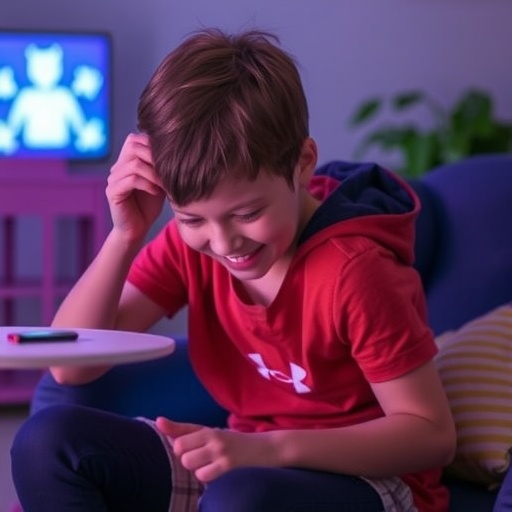In a transformative study published in BMC Pediatrics, researchers Gökoğlu and Sukut delve into the intricate relationship between distraction methods and the psychological responses of children undergoing invasive medical procedures. This groundbreaking randomized controlled trial meticulously explores how different forms of distraction—active and passive—impact children’s experiences of pain, fear, and anxiety, culminating in significant findings that could revolutionize pediatric care.
Children often encounter fear and anxiety during invasive medical procedures, leading to heightened distress. These emotional responses can exacerbate physical pain, creating a vicious cycle that complicates treatment. For years, healthcare professionals have recognized the essence of distraction as a coping mechanism to mitigate these challenges. However, the effectiveness of various distraction methodologies has remained a topic of debate within medical and psychological circles.
The research team conducted a rigorous series of experiments involving a diverse cohort of young participants, each tasked with undergoing a set of invasive procedures. The subjects were divided into different groups, engaging either in active distraction—such as playing games or engaging in interactive activities—or passive distraction, which consisted of watching videos or similar stationary activities. This methodical approach allowed researchers to draw nuanced comparisons between the emotional and physiological states of children in each group.
As the study unfolded, the children’s pain levels were meticulously measured through self-reports and observational indicators. The researchers also assessed levels of anxiety and fear before, during, and after the procedures. The results revealed a striking trend: children engaged in active distraction techniques reported lower pain levels and reduced anxiety compared to their peers engaged in passive distraction. This dichotomy suggests that the engagement and agency inherent in active entertainment provide a more effective buffer against distress.
One of the highlights of the study was the observation regarding the nature of the activities performed. Children who played interactive games exhibited not just lower pain perception but also a remarkable ability to manage anxiety levels. This can be attributed to the holistic engagement required in active play, which stimulates focus and fosters a sense of control that can significantly reduce distress in a clinical setting.
Contrastingly, the passive distraction methods, while somewhat effective, did not yield the same degree of positive outcomes. Watching videos, although an entertaining option, appeared to offer limited engagement and thus a reduced ability to distract from the procedural experience. The findings propose an essential reevaluation of how healthcare providers approach pediatric care, especially the value of incorporating more active engagement strategies in treatment protocols.
Further analysis of the study provided insights into the psychological mechanisms behind these responses. Active engagement in play activates the brain’s reward centers, releasing neurotransmitters such as dopamine, which can serve to enhance mood and alleviate stress. This neurochemical response potentially offsets the sensation of pain and fosters a more favorable psychological environment during medical interventions.
Moreover, the researchers noted that the choice of distraction technique also had implications for parental involvement, which is a critical component of pediatric care. Parents often feel powerless during medical procedures, and equipping them with knowledge about effective distraction strategies can enhance their role in supporting their children’s emotional well-being. The trial emphasizes the importance of a collaborative approach, bridging the gap between medical professionals, children, and their caregivers.
The clinical implications of this research extend beyond immediate procedural outcomes. By demonstrating the efficacy of active distraction techniques, healthcare providers are encouraged to develop tailored therapeutic interventions that prioritize children’s autonomy and engage their interests. The adoption of such strategies can lead to less anxiety-laden experiences not only for the children but also for their families.
As the medical community continues to evaluate the results of this captivating study, it is evident that findings hold a considerable promise for future pediatric practices. Incorporating games and active participation into clinical settings could reshape the landscape of how painful procedures are approached and carried out, ultimately enhancing the quality of care for children.
Given the growing awareness of mental health’s role in physical health outcomes, these findings contribute to an evolving conversation about pediatric care. The need for an integrative model that considers both the physical and psychological dimensions of treatment is paramount, particularly in settings that traditionally prioritize medical interventions without a holistic view of patient experience.
In conclusion, Gökoğlu and Sukut’s research on distraction methods in pediatric care shines a vital light on an often-overlooked aspect of medical treatment. The apparent efficacy of active engagement techniques offers healthcare providers innovative tools to alleviate the psychological burden associated with invasive medical procedures. This study not only enriches the body of knowledge around pediatric pain management but also opens avenues for future research into multimodal approaches that blend medical care with cognitive and emotional support.
As we look forward to seeing these findings implemented into clinical practice, the underlying message remains clear: when it comes to the care of children, innovative strategies that promote emotional and psychological well-being can lead to significantly improved health outcomes.
Subject of Research: Distraction methods’ effects on children’s pain, fear, and anxiety during invasive procedures.
Article Title: Should I play or should I watch: the effects of active and passive distraction methods on children’s pain, fear and anxiety during invasive procedures: a randomized controlled clinical trial.
Article References:
Gökoğlu, A., Sukut, Ö. Should I play or should I watch: the effects of active and passive distraction methods on children’s pain, fear and anxiety during invasive procedures: a randomized controlled clinical trial.
BMC Pediatr 25, 875 (2025). https://doi.org/10.1186/s12887-025-06188-1
Image Credits: AI Generated
DOI: 10.1186/s12887-025-06188-1
Keywords: Distraction methods, active engagement, pediatric pain management, anxiety in children, clinical trials.




